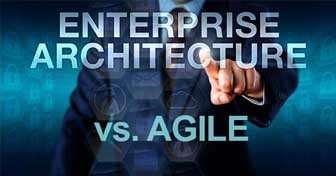Few, if any, companies can operate successfully today without the right information technology (IT) strategy. And as businesses grow, their IT needs and infrastructures become even more complex and costly.
This push and pull of managing growth while grappling with tech has brought two broad approaches to IT strategy to the forefront: enterprise architecture and Agile. Let’s look at both so you can contemplate where your company stands and whether an adjustment may be warranted.
Following a blueprint
As its name implies, enterprise architecture is a strategic philosophy that focuses on mindfully designing or adapting a companywide framework for choosing, implementing, operating and supporting technology.
Think of an architect drawing up a blueprint for a commercial building — every aspect of that structure will be thought through ahead of time to suit the size, operational needs and mission of the company. So it goes with enterprise architecture, which seeks to ensure every IT decision and move:
Aligns with the goals of the business. Everything done technologically flows from the company’s current goals as established through ongoing strategic planning. So, for example, no new software acquisitions or upgrades can occur without approval from the enterprise architecture unit, which can be a dedicated department or a special committee.
Complies with standardization and organization protocols. Businesses using enterprise architecture construct their IT systems to integrate seamlessly and follow stated rules for access, use, upgrades, cybersecurity and so forth. They also organize their systems to support digital transformation (digitalizing all areas of the business) and adapt relatively quickly to technological changes.
In some cases, complies with an established framework. There are various widely accepted enterprise architecture frameworks for companies that don’t wish to do it all themselves or would like a starting point. These include The Open Group Architecture Framework, the Zachman Framework and ArchiMate.
Being project-focused
Rather than being a top-down blueprint for IT strategy, Agile generally approaches business tech on a project-by-project basis. The idea is to be as nimble as possible. Some of its key features include:
- Breaking up IT projects into small pieces (often called “sprints” or “iterations”),
- Collaborating closely with customers (whether internal or external),
- Using cross-functional teams, rather than only IT staff,
- Focusing on continuous improvement during and after projects,
- Emphasizing flexibility over strict protocols, and
- Valuing interpersonal collaboration over processes and tools.
Like enterprise architecture, Agile also has different time-tested versions that many types of organizations have used. These include Scrum and Kanban.
Leaning one way or the other
Not too long ago, many large companies began leaning away from enterprise architecture and toward Agile. Some experts attribute this to increased reliance on cloud-based storage and software, which tends to decentralize IT infrastructure.
Earlier this year, however, market research firm Forrester released the results of a survey of 559 technology professionals worldwide in its Modern Technology Operations Survey, 2023 report. Of respondents who work for large enterprises, 55% said their organizations had an enterprise architecture unit. That’s an 8% increase from the 47% reported in the 2022 version.
Some experts believe the renewed emphasis on enterprise architecture could be a reaction to a couple potential downsides of relying largely or solely on Agile. That is, businesses running small, speedy IT projects with little to no oversight may encounter higher “technical debt” — the predicament of getting suboptimal project results that lead to costly downtime and rework. Companies may also suffer from “vendor sprawl,” a term that describes having too many software providers because Agile project teams act independently.
Managing the costs
To be clear, enterprise architecture and Agile aren’t mutually exclusive. Many companies use both approaches to some extent. Work with your leadership team and professional advisors to devise and execute your best IT strategy. We can help you quantify, track and manage your company’s technology costs.
© 2024




